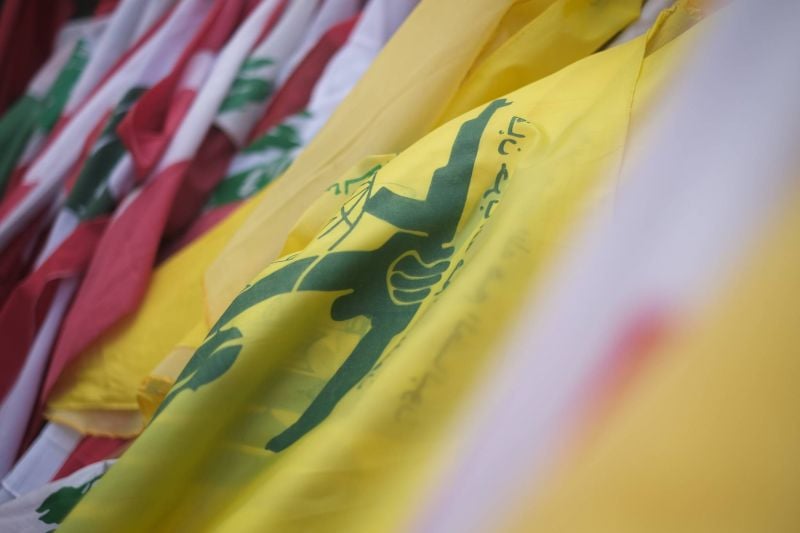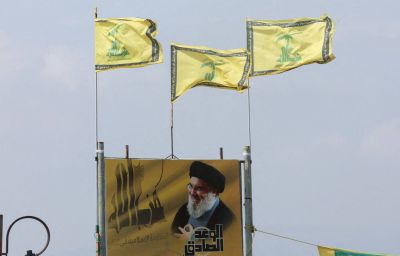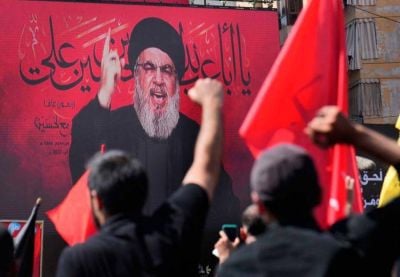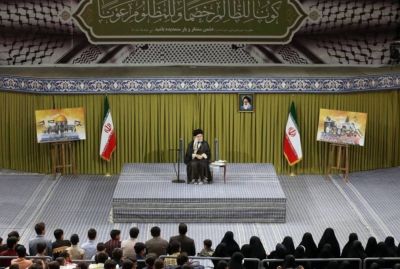
A Hezbollah flag at a rally in Lebanon in 2023. (Credit: João Sousa/L'Orient Today/File photo)
Follow our live coverage here.
In the ongoing almost month-long border-confined conflict between Hezbollah and Israel, the question remains of whether the situation will escalate into an all-out war in Lebanon.
It is a question that Hezbollah leader Hassan Nasrallah stopped short of concretely answering, as he took the podium Friday for his first speech since the conflict began.
Cross-border attacks between Hezbollah and Israel considerably escalated Thursday evening, prompting worries that the “rules of the game” that previously contained skirmishes between the two sides could soon change.
Thursday saw Israeli forces target areas around 22 southern Lebanese villages. Hezbollah conducted 20 cross-border attacks, causing "direct losses" in Israel. The group also executed their first explosive-laden drone strike on Israel. Additionally, Hamas fired a rocket from Lebanon towards the Israeli town of Kiryat Shmona. The Israeli military retaliated by targeting areas from which shells were launched across the border in southern Lebanon.
Does this escalation still fall within the rules of the game, or does it overstep the two sides’ red lines? We ask the experts.
What are the existing 'rules'?
Counterintuitively, Hezbollah and Israel have “a tacit understanding” of what is permissible and what is not within a certain context, Nicholas Blanford, a Beirut-based senior nonresident fellow with the Atlantic Council’s Middle East Programs, told L’Orient Today.
“The rules of the game are being made up as they go along,” he added.
In previous conflicts, adherence to such rules has been inconsistent, often resulting in tension and civilian casualties.
The "April Understanding" reached between Hezbollah and Israel in 1996 following the "Grapes of Wrath" conflict, sought to establish rules of engagement to protect civilians. But the agreement frequently faced strain. A similar pattern emerged during the enforcement of the United Nations' 1701 mandate, which was aimed at ending the 2006 war and called for the disarmament of non-state actors in Lebanon.
However, the current situation has taken many by surprise. “Obviously, the picture down south has changed significantly since the 90’s and 2006,” Blanford said.
The rules, from 2006 until Oct. 7 of this year, centered on limiting Hezbollah's cross-border strikes to the Israeli-occupied Shebaa Farms, considered a military zone with no Israeli civilians nearby, minimizing risks of escalation for both sides.
2023: Escalation, but it’s still (somewhat) proportionate
Of course, the cross-border strikes this time around have extended far beyond the bounds of the Shebaa Farms.
Hezbollah has resorted to using anti-tank missiles against Israel, while the latter targeted civilian buildings, marking a shift towards more lethal operations. This change in intensity has altered the longstanding pattern of clashes between the two parties.
Still, though the military strikes by both sides this year have increasingly breached established norms, they “would have, in other times, provoked a more extensive response,” David Wood, Crisis Group's Senior Analyst for Lebanon, told L’Orient Today.
Wood explained that there is a “new equation of proportionality;” an effort on both sides to keep responses to those operations, which are clearly beyond the rules of the game, proportionate.
Risks of miscalculation
But as long as there's no resolution in Gaza, the longer clashes between Israel and Hezbollah are likely to drag on.
And as the clashes continue, “the margin for error shrinks,” Wood told L’Orient Today.
“Each side wants to up the ante, to do something more forceful than they've done before, like using new weapons or attacking new areas to boost deterrence in the eyes of its enemy,” he added.
For example, Hezbollah and Hamas have hit the Israeli town of Kiryat Shmona more than once from Lebanon, striking civilian areas. However, a big-scale risk to civilians remains minimal since Israeli authorities had evacuated non-combatants from these areas.
“How do you continue to increase the threat without also increasing the risk that you'll hit something that you shouldn't have hit and that it's going to provoke a massive response from the other side?” Wood added.
Blurred red lines
What could push either side over the edge into a larger conflict?
Both parties are currently exercising caution due to their mutual deterrence, both experts explained. They aim to ensure that even in cases where there is behavior or operations that would have been deemed unacceptable in the past, their responses remain below the threshold of a full-scale war.
But this can change.
Hezbollah has threatened to intervene if the survival of Hamas is at stake, if the population of Gaza is displaced or if the status quo changes in the besieged enclave.
Still, “up until now, Hezbollah has deliberately framed its red lines and its triggers in really vague terms, which allows it to calibrate its response based on what it actually wants to do rather than what it feels that it must do,” Wood explained.
This is what Nasrallah described as 'constructive ambiguity' in his Friday speech.
While it remains highly speculative, but within the realms of possibility, Blanford listed some examples of different levels of escalation.
For example, “we could see Hezbollah staging small incursions across the border,” as “the area in northern Israel along the border is pretty much free of civilians now because they've been evacuated further south,” Blanford said.
“Hezbollah may stage a raid on an Israeli border position or on Israeli troops deployed up in the north,” he added. “We could see Hezbollah potentially using their drones to attack Israeli border positions or Israeli military equipment such as the Israeli listening post on Mount Meron or the Israeli Northern Command Headquarters in Safed.
And Israel could also escalate, he added.
“There is no shortage of targets for the Israelis. They could go for Hezbollah facilities around Lebanon — and not just stick to the border.”
Editor's note: This piece was updated following Hassan Nasrallah's speech on Friday afternoon.


